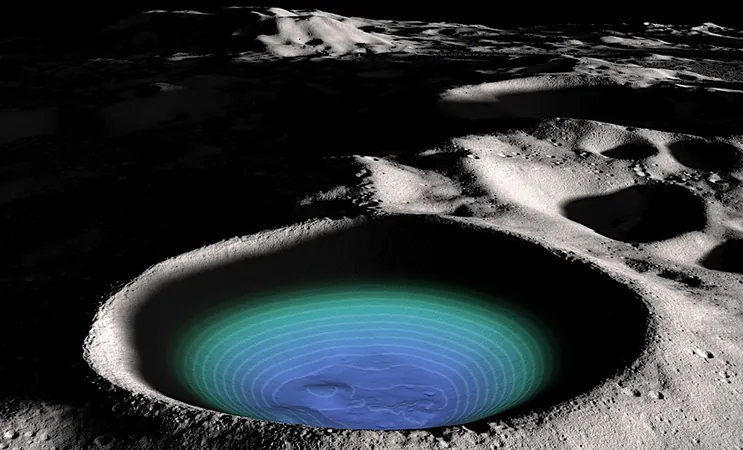
Unearthing the Cosmic Giant: A Massive Black Hole Revealed After 12.9 Billion Years
2025-03-31
Author: Jia
Astronomers have long grappled with the enigmatic nature of black holes, some of the most powerful and mysterious entities in the universe. Their immense gravitational pull is so potent that even light cannot escape their grasp, making them elusive targets for observation.
For years, researchers have sought to unravel the mysteries surrounding supermassive black holes—stellar giants residing at the centers of galaxies—especially during the formative years of the universe. However, thick clouds of interstellar dust and gas often obscure these ancient phenomena, complicating efforts to study their origins and growth.
Now, a groundbreaking study by an international team, which includes experts from The Australian National University (ANU), has unveiled unprecedented insights into a supermassive black hole that existed a mere 12.9 billion years ago—just a billion years after the Big Bang. This discovery offers an invaluable glimpse into a time when the cosmos was still in its infancy.
A Cosmic Colossus Cloaked in Dust
The focal point of the team's investigation is a supermassive black hole with a staggering mass exceeding one billion times that of our Sun. Despite its monumental size and energetic output, this black hole had remained largely concealed, shrouded in a veil of cosmic dust that thwarted traditional observational techniques.
Employing the remarkable capabilities of the Atacama Large Millimeter Array (ALMA), a sophisticated telescope located in Chile, the researchers were able to detect millimeter-wavelength radio signals that penetrate the dense dust clouds. Led by Professor Ken-ichi Tadaki from Hokkai-Gakuen University, the team employed this innovative approach to analyze the immediate surroundings of the black hole in extraordinary detail.
This pivotal research marks a significant advancement in understanding the environments of black holes during the universe's early epochs. It suggests that many more supermassive black holes may be lurking in similar dust-enshrouded regions, awaiting discovery.
Navigating the Challenges of Distant Quasars
Supermassive black holes are known for their ability to generate immense energy as they accrete surrounding matter, resulting in the formation of quasars—some of the brightest objects observable in the universe. However, even these luminous beacons face observational challenges; the vicinity around quasars is notoriously difficult to probe due to the obstructive presence of dust and gas.
Traditionally, scientists lacked effective methods to peer through this cosmic fog, but the innovative focus on radio waves employed by the ALMA team has forged a new path for study. The team was able to examine gas behavior a few hundred light-years from the black hole, offering new understanding into how these colossal entities evolve and exert influence over their environments.
Through meticulous analysis of molecular gas emissions, the researchers were able to reveal the dynamic forces at play in the black hole's immediate vicinity.
Revelations of Shock Waves and Intense Radiation
The findings of this study also illuminate how the energy stemming from the black hole modifies the adjacent gas. Dr. Takafumi Tsukui from ANU elaborated on their observations of heating mechanisms, commenting, "We discovered that intense X-ray radiation emitted by the spiraling material around the black hole, as well as strong winds and shock waves, elevate gas temperatures to levels far beyond what is typically seen in normal galactic environments.”
This significant finding uncovers an environment that is far more extreme than conventional star-forming galaxies, where energy predominantly derives from ultraviolet radiation from stars. The gas closer to the black hole is influenced dramatically by its violent surroundings, providing critical insights into tracing the growth of black holes across cosmic history.
A Revolutionary Approach to Discovering Hidden Black Holes
Interestingly, the study raises the tantalizing possibility that black holes like this one may not be rare, but rather numerous—hidden by the dust of the early universe. This cosmic obscurity absorbs visible and ultraviolet light, rendering traditional telescopes unable to unveil what lies beneath. However, radio waves, such as those detected by ALMA, can penetrate this veil without losing strength.
Dr. Tsukui noted, "Our findings enhance our understanding of how black holes evolve from tiny seeds in the early universe to supermassive black holes, highlighting the challenges posed by dust and gas that can obscure them." This crucial insight is expected to reshape astronomers’ search strategies for ancient black holes, placing greater emphasis on radio emissions rather than conventional visible light.
Unlocking Secrets in Molecular Gas
ALMA’s sensitivity to millimeter wavelengths is particularly advantageous for this breed of research. By focusing on emissions from carbon monoxide molecules, especially those in higher energy states, scientists can glean insights into the temperature and density of the gas surrounding black holes. This level of detail allows researchers to understand the impacts black holes have on their galactic environments.
This method may extend to other distant galaxies, paving the way for a broader survey of ancient black holes obscured by cosmic dust.
What Lies Beneath the Dust?
The implications of this research are profound, hinting at a vast and largely unseen population of supermassive black holes from the cosmos' early era. By applying similar techniques across the sky, astronomers can venture forth in their quest to identify and study these hidden giants. Each fresh observation draws us nearer to deciphering the formation of the universe's first galaxies and black holes.
As advancements in radio astronomy continue to evolve, our understanding of the ancient cosmos expands. The universe may still harbor many enigmas, but thanks to cutting-edge techniques, we are now better equipped to peer through the dust into the depths of time.
This remarkable study has been published in Nature Astronomy, marking a significant step in unraveling the mysteries of the universe. Journalists and astronomy enthusiasts alike are excited to follow the unfolding revelations that lie in wait among the stars.




 Brasil (PT)
Brasil (PT)
 Canada (EN)
Canada (EN)
 Chile (ES)
Chile (ES)
 Česko (CS)
Česko (CS)
 대한민국 (KO)
대한민국 (KO)
 España (ES)
España (ES)
 France (FR)
France (FR)
 Hong Kong (EN)
Hong Kong (EN)
 Italia (IT)
Italia (IT)
 日本 (JA)
日本 (JA)
 Magyarország (HU)
Magyarország (HU)
 Norge (NO)
Norge (NO)
 Polska (PL)
Polska (PL)
 Schweiz (DE)
Schweiz (DE)
 Singapore (EN)
Singapore (EN)
 Sverige (SV)
Sverige (SV)
 Suomi (FI)
Suomi (FI)
 Türkiye (TR)
Türkiye (TR)
 الإمارات العربية المتحدة (AR)
الإمارات العربية المتحدة (AR)